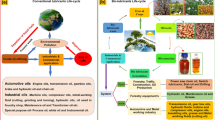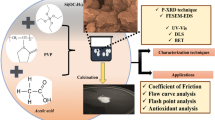Abstract
In this research study, the rheological and tribological properties of mahua oil (MO) and flaxseed oil (FO) were investigated by incorporating the TiO2, ZrO2, graphite, and MoS2 nanoparticles (NPs) as lubricant additives. The nanolubricants were synthesized by dispersing these NPs in MO and FO with varying concentrations from 0.25 to 1.25 wt.% through ultrasonicator and magnetic stirrer. The rheological tests were performed on a cone and plate rheometer, and the tribological test was performed on four-ball tester. The rheological test results depict that the nanolubricants exhibit Newtonian behavior at 40 °C and 100 °C. The tribological test results confirm that the average wear scar diameter (AWSD) of MO is much lower than FO and the maximum reduction in AWSD was 34.4%. TiO2 and graphite NPs exhibit excellent anti-wear properties in MO, and the maximum reduction in AWSD was 6.5% and 10.14% at an optimum concentration of NPs 0.75wt.%. ZrO2 and MoS2 NPs showed negative effects in MO, and maximum AWSD was observed at 0.75 wt.% and 0.5 wt.%, respectively. TiO2, ZrO2, and MoS2 NPs perform superior anti-wear properties in FO, and the maximum reduction in AWSD was 30.2%, 11.7%, and 15%, respectively. The optimum concentration of TiO2, ZrO2, and MoS2 NPs in FO was 0.25 wt.%, 0.75 wt.%, and 1 wt.%, respectively. The graphite NPs exhibit a lower reduction in wear in FO, and maximum reduction in AWSD was observed 4.5% at a concentration of 0.5wt.%. Among these NPs, graphite NPs could be considered the best suitable anti-wear nano additives for MO and TiO2 NPs for FO.















Similar content being viewed by others
References
Singh Y, Sharma A, Singla A (2019) Non-edible vegetable oil–based feedstocks capable of bio-lubricant production for automotive sector applications—a review. Environ Sci Pollut Res 26:14867–14882. https://doi.org/10.1007/s11356-019-05000-9
Willing A (2001) Lubricants based on renewable resources - an environmentally compatible alternative to mineral oil products. In: Chemosphere. pp 89–98
Erhan SZ, Sharma BK, Perez JM (2006) Oxidation and low temperature stability of vegetable oil-based lubricants. Ind Crops Prod 24:292–299. https://doi.org/10.1016/j.indcrop.2006.06.008
Shafi WK, Charoo MS (2019) Experimental study on rheological properties of vegetable oils mixed with titanium dioxide nanoparticles. J Brazilian Soc Mech Sci Eng 41. https://doi.org/10.1007/s40430-019-1905-6
Singh Y, Sharma A, Singh NK, Chen WH (2020) Development of bio-based lubricant from modified desert date oil (Balanites aegyptiaca) with copper nanoparticles addition and their tribological analysis. Fuel 259. https://doi.org/10.1016/j.fuel.2019.116259
Singh Y, Vyas D, Kumar N, et al (2019) Experimental evaluation on the tribological properties of cassia tora oil by the addition of copper nanoparticles. Int. J. Ambient Energy. https://doi.org/10.1080/01430750.2018.1563821
Alves SM, Barros BS, Trajano MF, et al (2013) Tribological behavior of vegetable oil-based lubricants with nanoparticles of oxides in boundary lubrication conditions. In: Tribology International. Elsevier Ltd, pp 28–36. https://doi.org/10.1016/j.triboint.2013.03.027
Mushtaq Z, Hanief M (2021) Evaluation of tribological performance of Jatropha oil modified with molybdenum disulphide micro-particles for steel-steel contacts. J Tribol 143:021401. https://doi.org/10.1115/1.4047752
Mushtaq Z, Hanief M (2021) Enhancing the tribological characteristics of Jatropha oil using Graphene nanoflakes. J Tribol 28:129–143
Sabarinath S, Prabha Rajeev S, Rajendra Kumar PK, Prabhakaran Nair K (2020) Development of fully formulated eco-friendly nanolubricant from sesame oil. Appl Nanosci 10:577–586. https://doi.org/10.1007/s13204-019-01121-2
Sabarinath S, Rajendrakumar PK, Prabhakaran Nair K (2019) Evaluation of tribological properties of sesame oil as biolubricant with SiO2 nanoparticles and imidazolium-based ionic liquid as hybrid additives. Proc Inst Mech Eng Part J J Eng Tribol 233:1306–1317. https://doi.org/10.1177/1350650119837831
Delgado-Tobón AE, Aperador-Chaparro WA, Misnaza-Rodríguez YG (2018) Evaluation of the lubricating power of chemical modified Sesame oil additivated with Cu and Al 2 O 3 nanoparticles. DYNA 85:93–100. https://doi.org/10.15446/dyna.v85n207.63189
Hernández Battez A, González R, Viesca JL et al (2008) CuO, ZrO2 and ZnO nanoparticles as antiwear additive in oil lubricants. Wear 265:422–428. https://doi.org/10.1016/j.wear.2007.11.013
Godiganur S, Suryanarayana Murthy CH, Reddy RP (2009) 6BTA 5.9 G2–1 Cummins engine performance and emission tests using methyl ester mahua (Madhuca indica) oil/diesel blends. Renew Energy 34:2172–2177. https://doi.org/10.1016/j.renene.2008.12.035
Ramesh K, Murugaveni SP, Shameer PM (2015) Investigations on the Performance and Emission Characteristics of a DI-Diesel Engine Fuelled with Mahua Biodiesel. International Journal of Applied Engineering Research 10(61):2015
Padhi SK, Singh RK (2010) Optimization of esterification and transesterification of Mahua (Madhuca Indica) oil for production of biodiesel. J Chem Pharm Res 2:599–608
Kumar P, Navindgi MC, Dutta M, Sudheer B (2012) Performance of a CI engine with different blends of Mahua (Madhuca Longifolia) biodiesel under varying operating conditions. Int J Eng Technol 2(7):1251–1255
Ghosal MK, Das DK, Pradhan SC, Sahoo N (2008) Performance study of diesel engine by using mahua methyl ester (biodiesel) and its blends with diesel fuel. Eng Technol X:1–9
Kumar D, Chibber VK, Singh A (2018) Physical and chemical properties of Mahua and Sal seed oils. In: Advances in Intelligent Systems and Computing. Springer Verlag, pp 1391–1400. https://doi.org/10.1007/978-981-10-5903-2_146
Dixit S, Kanakraj S, Rehman A (2012) Linseed oil as a potential resource for bio-diesel: a review. Renew Sustain Energy Rev 16:4415–4421
Malinowska M (2019) The full or partial replacement of commercial marine engine oil with bio oil, on the example of linseed oil. J KONES 26:129–135. https://doi.org/10.2478/kones-2019-0066
Singh Y, Singh NK, Sharma A et al (2020) Madhuca Indica (Mahua): a novel feedstock for bio based lubricant application treated with trimethylolpropane and tribological analysis. Aust J Mech Eng. https://doi.org/10.1080/14484846.2020.1842300
Suresha B, Hemanth G, Ananthapadmanabha, Kulkarni G (2020) Role of graphene nanoplatelets on tribological behaviour of Madhuca indica oil. In: AIP Conference Proceedings. Am Inst Phys Inc. https://doi.org/10.1063/5.0004145
Chaurasia SK, Sehgal AK, Singh NK (2020) Improved lubrication mechanism of chemically modified Mahua (Madhuca indica) oil with addition of copper oxide nanoparticles. J Bio- Tribo-Corrosion 6. https://doi.org/10.1007/s40735-020-00387-2
Sharma S, Tyagi H, Kumar N, Yadav V (2014) Comparative tribological investigation of mahua oil and its chemically modified derivatives. SAE Int J Fuels Lubr 7:360–365. https://doi.org/10.4271/2014-01-0956
Jeevan TP, Jayaram SR, Afzal A et al (2021) Machinability of AA6061 aluminum alloy and AISI 304L stainless steel using nonedible vegetable oils applied as minimum quantity lubrication. J Brazilian Soc Mech Sci Eng 43:1–18. https://doi.org/10.1007/s40430-021-02885-x
Baskar G, Gurugulladevi A, Nishanthini T et al (2017) Optimization and kinetics of biodiesel production from Mahua oil using manganese doped zinc oxide nanocatalyst. Renew Energy 103:641–646. https://doi.org/10.1016/j.renene.2016.10.077
Díez-Pascual AM, Díez-Vicente AL (2015) Development of linseed oil-TiO2 green nanocomposites as antimicrobial coatings. J Mater Chem B 3:4458–4471. https://doi.org/10.1039/c5tb00209e
Chen J, Soucek MD, Simonsick WJ, Celikay RW (2002) Synthesis and photopolymerization of norbornyl epoxidized linseed oil. Polymer (Guildf) 43:5379–5389. https://doi.org/10.1016/S0032-3861(02)00404-4
Salih N, Salimon J (2021) A review on new trends, challenges and prospects of ecofriendly friendly green food-grade biolubricants. Biointerface Res Appl Chem 12:1185–1207. https://doi.org/10.33263/briac121.11851207
Vijayalakshmi R, Rajendran V (2012) Synthesis and characterization of nano-TiO2 via different methods. Arch Appl Sci Res 4(2):1183–1190
Kotia A, Ghosh GK, Srivastava I et al (2019) Mechanism for improvement of friction/wear by using Al2O3 and SiO2/gear oil nanolubricants. J Alloys Compd 782:592–599. https://doi.org/10.1016/j.jallcom.2018.12.215
Pereira LGG, Pires CAM (2017) Effect of temperature on the flow profile of the bio-oil produced from the fast pyrolysis of sisal residue. Energy Fuels 31:2871–2878. https://doi.org/10.1021/acs.energyfuels.6b02799
Arumugam S, Sriram G (2013) Preliminary study of nano- and microscale TiO2 additives on tribological behavior of chemically modified rapeseed oil. Tribol Trans 56:797–805. https://doi.org/10.1080/10402004.2013.792977
Omrani E, Menezes PL, Rohatgi PK (2019) Effect of micro- and nano-sized carbonous solid lubricants as oil additives in nanofluid on tribological properties. Lubricants 7. https://doi.org/10.3390/lubricants7030025
Xie H, Jiang B, He J et al (2016) Lubrication performance of MoS2 and SiO2 nanoparticles as lubricant additives in magnesium alloy-steel contacts. Tribol Int 93:63–70. https://doi.org/10.1016/j.triboint.2015.08.009
Author information
Authors and Affiliations
Contributions
All authors whose names appear in the research paper contributed individually and collectively in the following:
1. In the development of nanoparticles and nano-lubricants.
2. In conducted experimental studies to test nano-lubricants.
3. In surface morphological studies and surface analytical studies.
4. In writing the research paper for publication.
Corresponding author
Ethics declarations
Conflict of interest
The authors declare no competing interests.
Additional information
Publisher's note
Springer Nature remains neutral with regard to jurisdictional claims in published maps and institutional affiliations.
Rights and permissions
Springer Nature or its licensor holds exclusive rights to this article under a publishing agreement with the author(s) or other rightsholder(s); author self-archiving of the accepted manuscript version of this article is solely governed by the terms of such publishing agreement and applicable law.
About this article
Cite this article
Gupta, H.S., Sehgal, R. & Wani, M.F. Tribological characterization of eco-friendly bio-based mahua and flaxseed oil through nanoparticles. Biomass Conv. Bioref. 14, 11251–11263 (2024). https://doi.org/10.1007/s13399-022-03174-w
Received:
Revised:
Accepted:
Published:
Issue Date:
DOI: https://doi.org/10.1007/s13399-022-03174-w




